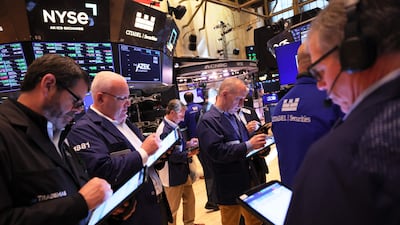Financial markets have, for now, largely shrugged off the noise surrounding the increase in the debt ceiling in the US.
US equities have rallied to a nine-month high and credit default swaps are indicating a roughly 4 per cent probability of a US debt default over the next year. That could change quite quickly as we near the “x-date” – the date at which the Treasury runs out of money to pay its bills, which Treasury Secretary Janet Yellen indicated could happen on June 1.
The US Treasury already hit its debt ceiling of $31.4 trillion in January, which means it is no longer able to issue new debt to finance budget shortfalls. Instead, the Treasury has been relying on cash in its accounts at the Federal Reserve, and “extraordinary measures” — effectively accounting entries — to meet its obligations.
The x-date is not fixed in stone, as the Treasury is still collecting tax revenue and may be able to get through the first week of June before it runs out of funds, but there is not much time left for congress to agree on a deal and pass the required legislation to prevent the US defaulting.
While all parties to the negotiations have indicated that they do not want to get to a point where the US is in default — an unprecedented event were it to occur — an agreement has not been reached as of May 19.
Republicans are calling for significant cuts to spending and some regulatory changes, while Democrats and the White House want an increase to the debt ceiling without any conditions, as the spending has already been approved by Congress in the last budget.
Clearly, the market expects an agreement to be reached before the US goes into default, but brinkmanship and delays could yet cause stress in the markets and have a negative impact on economic activity as borrowing costs could rise and businesses delay investment due to the high levels of uncertainty.
The last time the US came close to a default was in August 2011 during the Obama administration. The S&P 500 fell by 6 per cent in the fortnight prior to the debt ceiling being raised, as political wrangling continued until the very last minute.
Crucially, equities declined a further 13 per cent even after the necessary legislation was passed, and only started to recover in October 2011.
Rating agency Standard & Poor's downgraded the US’s credit rating to AA+ from AAA shortly after the debt ceiling was raised, citing, among other things, uncertainty about debt dynamics. Financing costs rose and private sector confidence declined even though a default was ultimately averted.
Most analysts expect a deal will be reached before the deadline to raise or suspend the debt ceiling.
Even in this baseline scenario, however, growth could be negatively affected in the near-term, with some job losses, if the negotiations go down to the wire. If the final agreement includes spending cuts or caps that come into effect immediately, then this could provide a further drag on economic activity.
However, there is a non-negligible risk that a compromise isn’t reached in time, or that the deal agreed isn’t passed by Congress. It is impossible to know with any certainty what the impact on financial markets and the global economy might be in this scenario, as there is no precedent to look to.
The severity of the shock would also depend on how long the situation lasts. Financial market volatility and the immediate political fallout of the US not being able to pay its bills would probably force all parties to reach an agreement on raising or suspending the debt ceiling before too much damage is done, perhaps within a week or two.
In this scenario, the Treasury would most probably prioritise the repayment of interest on its debt, while cutting back on all other spending including social security, Medicare, other benefit programmes, salaries of all federal employees and payments to contractors and suppliers.
Provided the delays in payments are not prolonged, the negative impact on economic activity and increase in unemployment would probably also be limited, but perhaps more severe than under the baseline scenario.
Khatija Haque is chief economist and head of research at Emirates NBD

